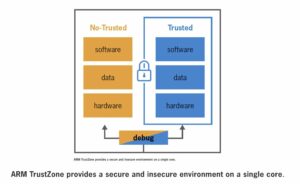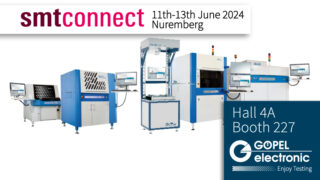eBOM takes a look at Rutronik’s secure MCU solution for edge intelligence in the Internet of Things (IoT).
AI (artificial intelligence) applications and services are increasingly being integrated into MCU platforms, especially in industrial environments. With an edge intelligence IoT MCU platform from Rutronik, hardware and firmware developers now have a complete edge computing solution for their AI-based applications.
End users and end devices at the network edge often generate massive amounts of data, including sensitive data that is governed by data protection legislation such as location data, health records, activity records and production information. Analyzing such data in the cloud or on edge systems entails a major risk of privacy violations – even when complying with legal requirements such as the General Data Protection Regulation (GDPR).
Years ago, real-time automation and control systems were largely developed as independent systems. Today, they are connected with networks through which sensitive data can be leaked or tampered with. In most cases, the system architecture does not provide adequate protection against such attacks. This is why data and algorithm security is very high on the list of priorities for industrial businesses.
Paradigm Shift from Cloud Computing to Edge Computing
Edge Intelligence (EI), a method of independent learning on the end devices themselves, is one way to enable distributed data learning in a way that is consistent with data protection interests. The original data records remain stored on the devices or nodes where they were generated, but the parameters of the edge AI model can be used for multiple end devices.
In Edge Intelligence, digital signal processing must be performed by the AI in the (I)IoT ([Industrial] Internet of Things) front end. This entails a genuine paradigm shift from wholly cloud-based intelligence to local smart digital signal processing in the end device.
For the EI services offered by various companies to be considered trustworthy, a decentralized trust model is required. Basic designs of distributed security mechanisms make it possible to ensure the implementation of user authentication, access control, model & data integrity and mutual platform verification. If the risk of both trustworthy and “malicious” edge nodes being present in the network cannot be eliminated, safe routing plans and trusted network topologies are necessary for providing EI services. New security mechanisms with trusted zones and cryptography-based algorithms are needed for all communication processes with the MCU and data storage. This applies to the entire process, from programming to algorithm training to the practical use in the field.
Key Criteria for EI-Based Systems
At least six criteria play an essential role in the performance of EI-based systems. They were also fundamental to the design of the RUTDevKit-STM32L5 Edge Intelligence IoT MCU platform from Rutronik:
- Latency
Latency is the time needed for the decision and inference process, including pre-processing, model inference, data transmission and post-processing. Assuming a latency of 100ms for the entire process, elements such as the analog sensor data signal process would have to be much shorter. Strict time limits apply in particular for mobile real-time applications such as robotics, predictive maintenance or sensor data fusion. In this case sampling rates of around 100kHz and the associated signal pre-processing are required. In the RUTDevKit-STM32L5, high-speed analog/digital converters (ADCs) for the STM32L05 provide the required latency values.
There are also other factors that affect latency, including the edge device resources and the data transmission method, as well as how the neural network is implemented in the software. In the RUTDevKit-STM32L5, the PSRAM Octo-SPI interface and the NOR flash Quad-SPI interface support the board’s real-time capabilities. They help achieve the fastest data transfer rates possible.
- Precision
Precision relates to the AI training model and thus also to the results of the AI model. It relates to the ratio of the number of data samples that produce correct predictions through inference to the total of data samples. The factors of influence include the speed at which the input data is fed into the AI model. For example, in a video analysis application, the right rate of input may result in data being skipped due to the limited resources of the edge device. This causes precision to suffer. On the other hand, a cameraless system such as blind spot detection in a car that is based on pulsed infrared sensor technology provides faster and more precise decision-making results. It is precisely for such applications with decentralized intelligence that MCU platforms are ideal.
Cameraless, EI-based gesture control with very low latency times has enabled the Halios family from Elmos, for example. Halios stands for High Ambient Light Independent Optical System. Its highly sensitive components detect gestures without any mechanical elements or camera-based systems. These can be superbly combined with the RUTDevKit-STM32L5.
- Energy Consumption
The work involved in calculation and communication when deriving results from an AI model consumes a fairly large amount of energy. This is a problem when implementing the AI model in the end device, because – unlike edge servers and cloud data centers – these devices are usually battery-powered. This is why energy efficiency is an important factor in EI applications. It depends on the size and complexity of the AI model and the resources on the edge devices. Efficient handling of memory space and communication times and a low-power/high-performance MCU reduce energy consumption.
- Data Protection
(I)IoT applications and devices also generate a lot of sensitive data, which is why privacy and data security must be ensured near the data source of an EI application. The method of processing of the original data plays a key role here. A “trust zone” in the MCU and data storage – a virtual area with hardware-based access controls – is therefore essential. The management of secure (trusted) and insecure (non-trusted) areas, stringent process planning for programming, and the application of restricted access rights in operation are critical here.
For secure machine learning processes involving quasi big data, the RUTDevKit-STM32L5 has an SD card slot. This allows an encryption-capable SD card to be added in order to protect valuable data.
- Communication
External communication with other EI systems plays an especially large role in a system’s real-time capability. To keep latency as low as possible, this communication overhead must be minimized during the inference phase. This is especially true of the heavy usage of WAN bandwidth in the cloud.
An Anybus module is available for the RUTDevKit-STM32L5 that enables communication across all standard fieldbuses and Industrial Ethernet networks, relieving the burden on the MCU’s computing performance.
- Memory
A high-precision AI model is typically based on an extremely high number of data records. However, for mobile and battery-powered devices, the focus tends to be more on reducing storage resources. To be able to store big data and inference data securely on such devices, it is important to optimize storage peripherals for the AI implementation.
The RUTDevKit-STM32L5 features 412kB flash memory, 64Mb PSRAM and 128Mb NOR flash memory on the MCU chip, plus a slot for an SD card in the GB segment with a secure area to provide the ideal conditions for machine learning applications.
Ensure secure connectivity
For many applications, it may make sense to run AI models not in the cloud, but on edge devices. Its latest development, the RUTDevKit-STM32L5, is Rutronik’s important contribution to ensuring secure, autonomous systems with adequate connectivity. The complete solution for AI-based edge applications run on an MCU platform enables hardware and firmware developers to create proofs of concept in a very short time. They enhance system efficiency and scalability, while reducing development time and cost.
The RUTDevKit-STM32L5 provides a basis for a modular toolkit. Arduino compatible plug-in boards that enable feasible solution concepts for specific end applications are under development.
The RUTDevKit-STM32L5 – an Edge Intelligence IoT MCU Platform
The RUTDevKit-STM32L5 provides hardware and firmware developers with a complete solution for in-house development of AI-based edge applications. The BOM includes only components from the Rutronik portfolio. It can be found at www.rutronik.com/development-stories/rutdevkit-stm32l5 and can be easily adapted for any application. The components at a glance:
Hardware
- STM32L562ZET6Q ultra-low power IoT controller (110MHz), ARM Cortex-M33 TrustZone with 512kB flash, on-chip PSRAM and NOR flash connected via Octo-SPI, Arduino pin connectors, access to microcontroller IO pins, ST-Link USB debugger
- APS6408L 64Mb Octo-SPI PSRAM
- EN25QH128A 128Mb Quad-SPI NOR flash
- CAN FD with TLE9251VLE driver
- USB-C power supply with protection IC TCPP01-M12
- RS-485 interface with ST3485EDBR driver
- Micro-SD card slot
- Arduino interface
- 4-layer design
Software
- CAN-FD test mode demo
- RS-485 Modbus demo
- USB power supply demo
- Dual bank flash bootloader demo
- TrustZone demo
- Tamper detection demo
Get more information about the DevKit here.
Company: Rutronik











